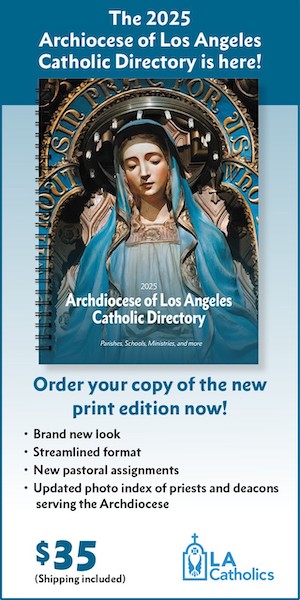The Catholic Church has a varied and full list of personal devotional prayer forms that we have inherited over the centuries from all over the world. Consider the Rosary, Our Lady of Lavang, Our Lady of Guadalupe, Our Lady of Peace, the Sacred Heart of Jesus, Santo Nino, Divine Mercy, and the list goes on. We also have older forms of personal prayer that have taken root again in recent years, such as contemplative prayer and lectio divina, and currently there is a strong movement towards Catholic meditation. Participating in any one of these forms of prayer is a personal choice.
Partnered with these prayer forms is Sunday Mass, our quintessential communal prayer as church. Our full, conscious and active participation in the weekly proclamation of God’s Word, acclamation of Christ’s presence in the Eucharist, and sharing in communion is what forms us as Catholic. The Liturgy of the Hours, too, is a public communal act of Catholic worship. Just as the Mass glorifies God and sanctifies humanity, the Liturgy of the Hours extends the action of the church, imbued with the holiness of God, throughout the day. Sunday Mass and the Liturgy of the Hours (especially Morning and Evening Prayer) are both official liturgies of the church. Other forms of prayer outside of these two forms are the private personal choice of each individual Catholic. This is an important distinction.
Personal prayer choices assist us in maintaining and strengthening our individual relationship with God so that when we return to Mass (or the Liturgy of the Hours), our participation, understanding and commitment to life in Christ continues to grow and bear fruit. One form of prayer nourishes the other, but note the difference in approach. The Mass is so much more than personal prayer. Full participation at Mass is who we are as church, as one visible and concrete body of Christ still present and alive here on earth. At Mass, we are called to sacrifice our individuality to the cohesive body, one body in Christ. At Mass, together we become a presence that is so much more than the sum of our individual selves. We become like starlings flying in formation. Our murmuration embodies Christ, and emboldens us. It gives the community wings and radiates the presence of God to all humanity. We, the church, as one body of Christ, remember God’s saving power, and continue to give it voice and presence in the world today. Our participation at Mass is not for ourselves alone, but for others. Worshipping like a “murmuration,” a “one-body” community, is essential to the meaning and purpose of the Mass. We are not just individuals at private prayer who happen to be together. Our “one-bodiness” is what makes liturgical prayer different from individual devotional prayer forms. That “one-bodiness” is the very intention of our liturgical prayer. At Sunday Mass, we stand as a people fused together in a given moment and place, for a purpose outside of our individual needs. If we mistakenly equate personal devotional practice with participation at Sunday Mass, we lessen our understanding of each and its unique place in our lives as Catholics. Yes, Sunday Mass is a personal prayer experience, but it is also much more than that.
Before the Lenten season begins (Ash Wednesday is February 14, 2018), consider spending some time reflecting on what full, conscious and active participation at Sunday Mass could be like in this broader awareness. Does vivifying, visible and vibrant liturgical participation matter? What would its effects look like and feel like and lead to? What can we do to move ourselves from prayers of personal concern into prayers of Kingdom (of God) concern? What must we do to find this fuller participation?
“…liturgy is a process by which we are taken up into something that transcends our individual lives and become involved in an enterprise that is far more than the sum of the efforts of the individual participants.” (Mark Searle, Called to Participate, Liturgical Press, 2006, p. 15)
The “butterfly effect” is a concept first imagined by the American meteorologist Edward N. Lorenz (1917-2008) highlighting the possibility that small causes may have momentous effects. Could the flap of butterfly wings mean a turn of events for wind and weather? Applying this concept as a general metaphor, could the actions of each individual have the potential to be a “butterfly effect,” turning the course of events? Could changing how I participate in the liturgy make a difference in my life? Could an explosion of participation at Sunday Mass be a “butterfly effect” in the church? Could something so simple as fuller, more conscious, more active participation by everyone at Mass change the world?
Interested in more? Subscribe to Angelus News to get daily articles sent to your inbox.

